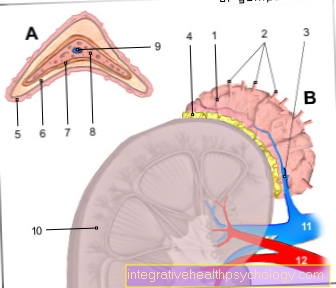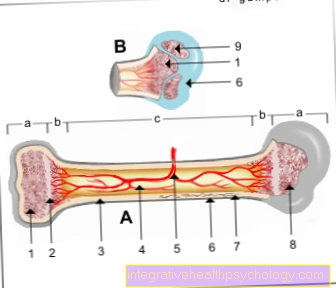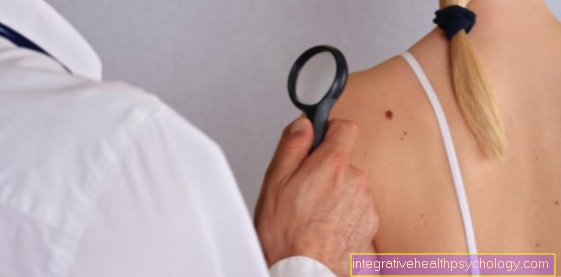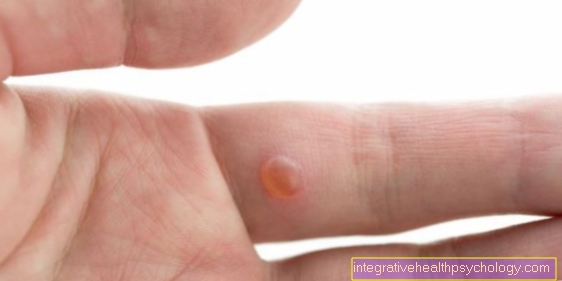Positional vertigo
introduction
The benign, seizure type Positional vertigo is a common but harmless disease that is perceived by those affected as very unpleasant and threatening.
Delayed diagnosis and lost time until the start of therapy also result in unnecessary ones fearswhich can lead to a further worsening of the symptoms.

Synonyms
- BPLS - benign paroxysmal positional vertigo
- BPPV - benign paroxysmal positional vertigo
- BPPV - benign peripheral paroxysmal positional vertigo
- Canalolithiasis
- Cupolithiasis
definition
Of the benign positional vertigo is the am in the neurological outpatient department most frequently asked dizziness diagnosis.
Although benign positional vertigo can in most cases be determined with simple examination methods (positional test, Dix-Hallpike test) and, if the diagnosis is correct, a quickly effective, harmless treatment can be successfully applied, the clarification often takes too long or even becomes not correctly diagnosed.
Sometimes further examinations are necessary for the differential diagnosis of the cause of the vertigo. Delayed or incorrect diagnosis increases the burden on the patient as well as the costs for useless examinations and unsuccessful attempts at therapy.
Symptoms
Benign positional vertigo is an episodic, head and body position dependent vertigo, the cause of which lies in the inner ear (labyrinth). If the head position changes quickly, dizziness sets in, e.g. when turning over in bed, when getting up from lying to sitting or dizziness when bending over with a slight delay, and causes those affected to feel as though they have been turned around their own axis. You may also feel dizzy when you lie down.
A typical triggering change in position is turning the body towards the affected ear and / or turning the head towards the affected side, combined with a stretching of the cervical spine.
Concomitant symptoms of dizziness are nystagmus (rapid, uncontrolled "eye tremors" when the head is tilted to the affected side and reversal of the eye tremors when straightening up) and nausea when conscious.
The vertigo attack of positional vertigo begins a few seconds after the beginning of the head movement (with slow movement, the attack is weaker or does not occur at all) and lasts on average about 10 - 40 seconds. The intensity of vertigo increases very quickly with the beginning of the change in position then slowly fade away again after reaching the resting position until you are free from vertigo. If the dizziness is repeatedly triggered by the corresponding head or body movement, the intensity of the dizziness decreases continuously until it disappears completely. Between the attacks of vertigo, those affected are symptom-free.
The benign positional vertigo often disappears on its own after a few weeks, but has a high recurrence rate (relapse rate). With a correct diagnosis and appropriate treatment, the benign positional vertigo disappears significantly faster, sometimes even after a positioning exercise.
Read more on the topic: Dizziness in the head.
causes
As the cause of the benign, seizures occurring Positional shrinkagel are called otoliths (Ear stones made from calcium carbonate crystals) believed to be different from the sensory epithelium of a Balance organ (mostly from the utricle) in the Inner ear loosen, slip and get into one of the semicircular canals of the inner ear (Canalolithiasis).
Why such a replacement ultimately occurs is up to now not yet fully understood.
The Otoliths are usually used to ensure that, through their weight and inertia, the Perception of accelerations and serve the direction of the acting gravity.
With different head movements these move loosened, in the Semicircular canals located Otoliths back and forth, so that specific semicircular canal receptors are stimulated and nerve impulses are sent to the brain reports apparent movementsthat other sense organs are not registered. This different information (vestibular mismatch), which can often be completely opposite, ultimately lead to the typical Vertigo symptoms.
In principle, the detached can become Otoliths located in all three semicircular canals, but most often they get to the posterior, vertical (70-80%).
In the cause, however, a distinction is still made whether it is intact or aged, degenerative otoliths acts that peel off:
Because the Positional vertigo occurs more frequently in old age (> 50%), the assumption is that otoliths are more common, which detach and slip as part of the aging process.
In the same way, however, completely intact otoliths can also be detached, which in turn can affect every age group. Factors that increase the risk of this are, for example, a previous one Traumatic brain injury (20%), Inflammation or Dysfunction of the inner ear (15%, e.g. vestibular neuritis) Inner ear operations, an existing one migraine or an already known one Meniere's disease.
therapy
The treatment of benign positional vertigo consists purely in the implementation of various Exercises or maneuverswho aim to be detached freely movable Otoliths to be removed in the respective semicircular canal and transported back to the organ of equilibrium.
During these so-called liberation maneuvers, the person affected is repositioned several times in a certain order so that the otoliths follow gravity and slide back into their original position.
Depending on, which semicircular canal the Otoliths a different maneuver must be used: the most frequently affected posterior, vertical semicircular canal can be accessed through the Sermont- or Epley maneuver be freed.
If one of the other two semicircular canals is affected, the maneuvers follow Lempert and Tiel-Wilk or Rahko in question.
These exercises are usually carried out by the attending physician, but they can also be done by the person concerned at home on their own responsibility.
Usually it already follows 1-7 maneuver applications to a significant improvement, so that in over 80% of the cases these measures are successful and lead to the complete disappearance of the symptoms within 24 hours.
In some cases, however, it can also be Recurrence of the symptoms or dizziness.
An effective drug therapy, however, is not known. Alternative measures, such as chirotherapeutic treatments in the area of the cervical spine or the implementation of acupuncture proved ineffective.
Medicines can only be used in this disease purely symptomatic Treatment (e.g. treatment of the possibly beginning Nausea), just as can homeopathic therapeutic approaches be tried.
In general, that a Vavoid of movements is rather a hindrance, even if the dizziness can cause discomfort and anxiety: VA lot of exercise is beneficial.
Exercises
To treat the benign Positional vertigo Different exercises or so-called maneuvers are used, which serve to detach those that are free in the respective semicircular canal Otoliths remove from this and again back into the balance organ to maneuver. The maneuvers are usually carried out by the attending physician, but can also be done independently by the patient himself. Read about this: Positional vertigo exercises
Because the Otoliths in most cases are in the posterior, vertical semicircular canal, the exercises or positioning maneuvers are the main task Sermon and Epley to use.
In which Maneuver after Sermon the patient initially sits upright on the treatment couch. Next is the head around 45 ° to the healthy side (e.g. turned to the left if the right inner ear is affected). Then the patient becomes abrupt laid sideways on the sick sidewithout changing the head position. After 2-3 minutes, during which dizziness can occur, the squick repositioning by 180 ° laid on the other side in the sideways position without moving the head out of position. Here, too, the patient is paused for 2-3 minutes until the patient is finally raised up into a sitting position and waits for another 5 minutes.
The Exercise after Epley begins, however, in an upright sitting position on the examination table, where the Legs stretched out are on the couch. Now the head is over 45 ° to the affected side turned and the patient then abruptly to the supine position positioned so that the head without changing the line of sight, comes to lie beyond the end of the bed. After a minute, the head will turn over quickly Turned 90 ° to the other side and wait again briefly. Then the patient turns on the healthy side and slowly straighten up into an upright sitting position.
In more than 80% of the cases, these two maneuvers result in one success and the Positional vertigo disappears. However, many patients experience recurring positional vertigo after a while. If such a relapse occurs or if the maneuvers according to Sermon and Epley are not applicable for certain reasons, that can be Brandt-Daroff maneuvers should be considered: the patient is seated again in an upright sitting position on a lounger. Then he lies down quickly to the affected Side, with the head in the straight position looking straight ahead. After the dizziness has ceased, the patient sits up again in the sitting position. Next repeated he same to the healthy side.
If, in rare cases, one of the other two semicircular canals is affected, other exercises such as this can be used Maneuvers to Lempert and Tiel-Wilk or Rahko in question.
homeopathy
In the homeopathy There are several remedies that are used for use in treating vertigo in general.
By being dizzy numerous causes and the location of the illness that leads to dizziness is different in the case of the various vertigo illnesses, homeopathic therapy is usually a detailed and individualized one History of dizziness performed to a specific drug choice to be able to meet.
Based on the individually described symptoms, the appropriate remedy can be selected from a large number of vertigo sub-headings.
Since the Positional vertigo characteristically around acute onset of vertigo when changing position in the Lying down (turning over) or Change of position from lying to standing or from standing to lying down, come above all Belladonna (Deadly nightshade) and Conium maculatum (spotted hemlock) for use.
Both homeopathic remedies are in the form of Globules or drops given, mostly in the Potencies D2 (Conium maculatum) or. D6 (Belladonna) to D30.
Summary
The benign, paroxysmal positional vertigo is a common but harmless disease that is perceived by those affected as very unpleasant and threatening. Delayed diagnosis and lost time until the start of therapy also develop unnecessary fears, which can lead to a further worsening of the symptoms.





























